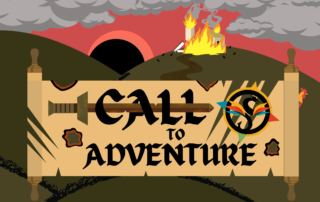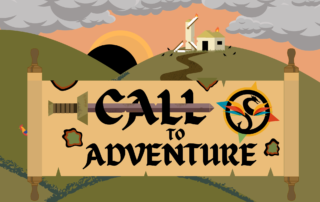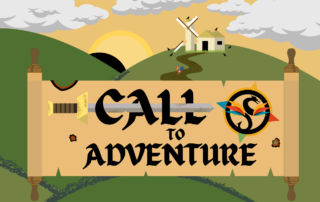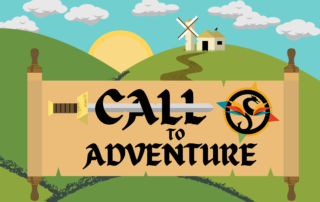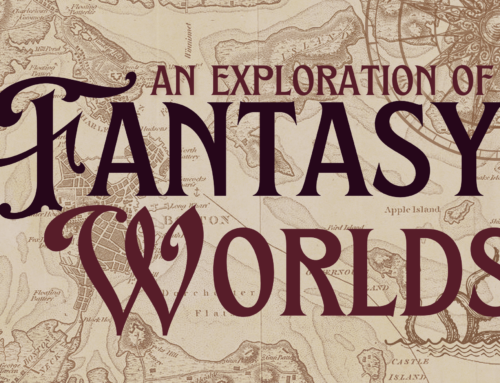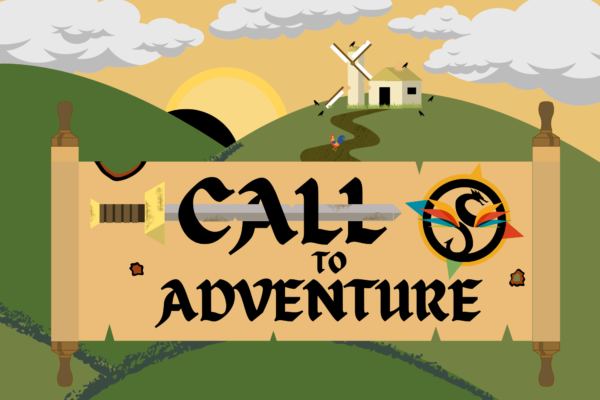
Chapter 3: Raiders of the Lost D-ark-ness
As you and your feathered companion make your way through the Shaded Woods, you realize your waterskin is beginning to run low. It will take 3 days to traverse the forest in good traveling conditions. You remember that there is only one freshwater source that is safe to drink from in the forest: Lake Nest. If you pass the lake now, you will run the risk of having to backtrack to get back to it, wasting hours of travel time. If you get lost in the forest, you’ll also run the risk of dehydration if you get sidetracked or lost (which has happened to many travelers in the past). You decide to make a detour to the lake to resupply for the journey ahead.
As you go down the path through the forest, you take a marked route through the trees indicating the way to Lake Nest. After a few minutes of traveling through thick underbrush, you manage to make it to the edge of the lake. You have never seen Lake Nest in person, but it is much larger than you expected.
You gather some water from the lake and find a clearing to start a fire for boiling. While the lake is supposed to be the cleanest freshwater source in the area, you do not want to risk getting ill from something in the water. You shudder at the thought of seeing the headstones of traders at the local cemetery who died of something called “Dyson-Terry Illness.” Most of them had been traveling west through the Orderon Trail, but made the mistake of drinking tainted water at the suggestion of their caravan leaders, Dyson and Terry. Strangely, the oxen that were pulling the caravans survived and made it to their destination. They still had the trade items hitched to their harnesses, but since there were no traders left on the caravan, the town claimed the items by way of the “Dibs Accord,” where the unclaimed items were taken by the mayor after saying “I call dibs on this caravan.” You remember hearing that the town became a financial center and the oxen became town heroes.
After your mind goes on that tangent, you remember your original purpose of boiling water. The area is still damp from the rain earlier that day, so you struggle to find dry materials to start the fire. You gather enough materials and get your tinderbox ready to light. As you get ready to spark it, you hear a splash coming from the lake. You look up and see a large creature rising out of the water. It is grey in color with leathery skin, and a long neck like a snake. Most of its body is submerged in the lake, but a small portion of it is showing just above the surface, forming a hump. It seems gentle in nature, staring at you curiously. You stand up and walk carefully towards the beast. You realize that it must be the Lake Nest Monster, a legendary animal that supposedly lives in these waters. No one has ever been able to prove its existence, though a local who claims to have seen it described it in the local parchment, The Everyday Looking-Glass. Realizing that it will not harm you, you reach out a hand to show it you mean no harm. It sniffs you and it relaxes a bit. Then, it makes a gurgling noise. Its eyes roll back and it opens its mouth. Out of nowhere, a blast of water explodes out of the creature’s throat, hitting you like a wall. The continuous stream knocks you off your feet, drenching you from head to toe. Eventually, the monster closes its mouth, making a small hiccup sound before turning around and swimming back towards the center of the lake. As you pick yourself up, you can vaguely see the Lake Nest Monster in the distance. Through blurred vision, you can make it out as this weirdly-shaped tree-trunk in the distance before it disappears under the surface of the water.

You try to dry off as much as you can and the rooster shakes off any water remaining on its feathers. However, you realize that you lost your flint and steel somewhere in the mud. Night is coming and all the things you need to start a fire are either lost or destroyed. You sit there dismayed, wondering how you will survive the night without a light source. As dusk approaches, you look up and notice small lights flickering by the tall grass. You approach them and realize that they are just sunflies signaling to each other. You stare at them for a while, comforted by their glow.
Then, you come up with an idea. You grab the glass jar from your pack and carefully catch several sunflies in it. After covering the jar, you grab a long, straight stick and roughly carve it into a new, non-magical walking stick with your dagger. You attach the jar to the end of the stick with some extra twine from your bag. You lightly shake the stick, causing the sunflies in the jar to brighten up, illuminating the entire area. Above you, the clouds begin to darken and thicken, meaning a storm is coming. You grab your equipment and light your way through the forest with the sunfly jar, hoping to find shelter along the way.
Navigating the dark is harder than you think and you get lost on the way back to the main path. After a few minutes of traveling, you encounter the entrance to a large cave system. The symbols around the entrance indicate that it is an old dwarven mine. You decide to take shelter there just as the storm begins.
You grab a large leaf nearby and attach it to a crack in the rock wall just outside of the mine entrance. After a bit of adjustment, you manage to angle the leaf so that any rainwater that lands on it drips into your waterskin. Due to the strength of the storm, your container fills with fresh drinking water in no time. You then turn your attention to the mine.
A passing blacksmith once spoke with Farmer Chuck and had a conversation about dwarven mines. He explained that their mines always had one exit. They use a minecart system to bring mined ores and gems to caravans on a nearby trade route. If you can find the beginning of the cart tracks in the cave, you can use it to lead you back to the main road. You walk a little bit into the mine to investigate the supports, making sure that it is still safe to travel through. However, a bolt of lightning strikes a large tree nearby, causing it to burst into flames and topple over. The tree strikes the support strut above the mouth of the mine, causing the entrance to cave in with several tons of rock. The rooster looks at you in terror as you both come to the same realization: there is only one way out of this mine, and neither of you are sure that it the exit is still intact. With a deep breath, you both venture deeper into the mine, hoping there is a way out.
The sunfly jar makes the pitch black cave somewhat easier to navigate. Along the way, you spot ancient tools the dwarves used during their mining operation, including old pickaxes, anvils, and hammers. You consider looting the cave to sell the items for a decent profit later. Under a pile of rocks and ore, you spot something shiny. You clear out the rocks and find a fairly large ingot of metal. It is bronze in color, but with a slightly gold tinge to it. Despite the age of the mine, it does not look like the ingot is corroding or rusting. You take it with you in your bag, hoping to get it appraised by a merchant. You grab a nearby pickaxe and hammer, but the words “You have reached your carrying limit” pop up in your mind. You shake your head, thinking the noise from the cave-in and the stress of being trapped in the mine are making you imagine things. Realizing you cannot carry any more supplies without burdening yourself, you drop both items, deciding to only take small items along the way.
After a bit of walking, you end up in a large, open cavern. You believe this must be where most of the ores were mined from.
A sudden guttural growl startles you. You cut the twine attaching the jar to your staff and cover it with your cloak, masking the light from anything that might spot you. You and the rooster hide behind a small outcrop of rock and listen.
The growl is rhythmic and you hear it coming from different sources in the cavern just ahead of you. You listen carefully and you realize that the creatures are not growling.
They’re snoring.
Next to you, you find the metal shell of an old signal lantern. You place the sunfly jar in the lantern, which fits snugly inside. Instead of lighting up the whole cavern, the signal lantern only shines a small beam of light through a round window at the front. You carefully direct the light into the darkness towards the snoring.
You do not see anything at first. You angle your light to the left and it shines on a strange-looking banner. The cloth is torn, with a primitive symbol drawn on it with a slimy green liquid. It is hanging from a large gnawed bone adorned with the skull of a tusked beast. Banners like these mean only one thing in this land: a goblin raiding party.
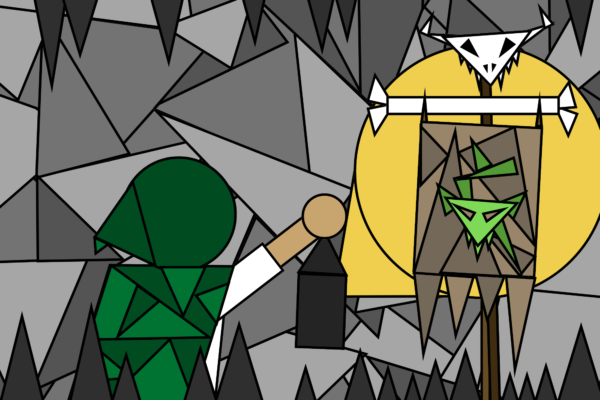
You shine the light to the area beneath the banner and realize there are dozens of green, muscular, human-like creatures in the cave. They are covered in tattered animal hides and are surrounded by barbaric weapons made of wood, crude iron, and bones. They must be the goblin raiders mentioned by the merchant in Milkvale. When you were preoccupied at the lake, they must have marched past you and set a camp in the mine to wait out the storm. On the other side of the cave, you spot a large metal container on some iron railings. It must be a minecart and the exit tracks. You dim the light with the lever on the lantern and look at the rooster. It shakes its head in fear, knowing what you are about to do: sneak past the raiders to get to the exit.
You begin tip-toeing past the horde, carefully avoiding any loose gravel, weapons, and goblin toes, knowing all too well what would happen if you make any loud noises. Suddenly, a goblin laying down next to you reaches towards your leg in a dream-like state, grumbling something about wanting a boar leg. In a panic, you grab a bone of something they ate next to you and hand it to the goblin’s outstretched arm. It grabs the bone and hugs it like a stuffed animal, falling back asleep as it begins gnawing on the bits of meat left on it. As you walk past the goblins, you see two pouches near what appears to be the goblin war-chief. One was filled with a sand-like black powder, and the other had small wooden orbs with cloth sticking out of each one. Towns in the region reported sightings of goblin raiders pouring a similar black substance into oddly-shaped containers ignited by flint and steel to cause destruction in their path. You decide that they will be a useful tool on the journey ahead, so you grab both bags as you pass by.
You reach the end of the cavern with a sigh of relief. You look around, wondering where the rooster went. There is a small rustling sound a few feet away from you and you shine the lantern towards it. You see that the rooster’s leg is caught on a piece of leather attached to something in the pocket of one of the raiders. As it tries to struggle free, the rooster freezes. Its eye glaze over and starts clucking. You realize what it is doing. The rooster only acts like that when dawn is approaching, instinctually knowing the exact time it has to wake the farmer for a new day.
The rooster struggles, jumping in and out of consciousness to fight the urge to start crowing. Then, it freezes. You realize it has lost the battle. Dawn is upon us.
The rooster ruffles its feathers.
You look around in a panic, trying to find a place to hide.
It uses its talons to scrape the ground.
You jump into the mine cart hoping it will start rolling down the tracks.
Its red crown stretches out.
You spot the lever that activates the mine cart mechanism a few feet away.
The rooster takes a deep breath.
Grabbing a rusty hammer in the cart, you aim at the lever.
CAWWWWWWWWWWWW!
Its cry echoes across the cavern, jolting the goblins awake. They spot the light coming from your lantern, flying into a frenzy as they grab their weapons. In the chaos, the rooster escapes and dashes for the mine cart. As it gets in, you throw the hammer at the lever, striking it hard. You hear the grinding of gears as the cart activates, slowly moving forward at first. The goblins have rallied, madly rushing towards the cart. They will be upon you in seconds.
Suddenly, the mechanism below the cart makes a loud THUNK and the cart dashes down the track at a speed no horse could match. You grasp the front of the cart hoping you don’t fly out. Deep down, you also hope the contents of your stomach don’t fly out. Next to you, the rooster is holding on for dear life on the same railing. After what feels like the longest 10 seconds of your life, you see light at the end of the tunnel. The breaks on the cart activate and it slows down as it reaches the exit. It makes a full stop at the end of the tracks. Then, another mechanism whirrs underneath the cart, causing it to tilt, depositing you and your companion on the gravel below.
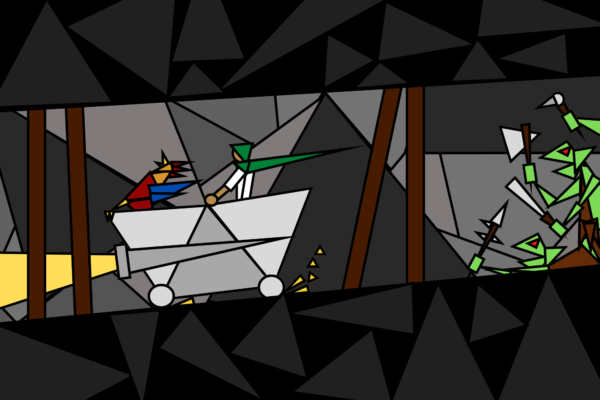
You stand up, shaking and wobbling from that experience. Dwarves may be renowned for their ingenuity, but they are infamous for their lack of quality control and annual safety inspections.
Your recovery is short-lived, as you hear the goblins’ cries echoing from the cave entrance. You will not be able to outrun them and they are getting closer and closer. You look up and see that the same wooden strut as the entrance supports the exit. Remembering the black powder orbs you looted from the war-chief, you pull out one canister and grab a handful of the dark substance. You frantically shove the powder into the hole on top and plug it with the cloth firestarter the orb came with. Your heart sinks as you remember that you lost your tinderbox at the lake. Without a striker, your orb is useless.
You hear a cluck nearby and spot the rooster hobbling by. You notice the leather it was stuck on earlier is still attached to its leg. A piece of metal is dangling off the other end of the leather. Your eyes widen as you realize it is the sparking portion of a fire striker.
You dive for the rooster and grab the sparker. Then, you pull out the old bronze knife from its sheath on your belt and strike the steel over the cloth attached to the orb, igniting it instantly. You toss the orb at the support strut and dive behind the mine cart.
The goblins are almost at the exit, snarling and roaring as they sprint towards you. The cloth burns to the end of the orb, causing it to explode into a ball of fire. It destroys the support strut holding the cavern open, collapsing the exit with a pile of earth and stone.
You peek out from behind the cart and examine the exit of the mine. With the mine caved-in on both ends, the goblins will be trapped there forever, preventing them from raiding the rest of the county. You take a deep breath knowing that the rest of your journey to Castor will be significantly safer without a raiding party on your heels. The words “Stealth +10,” “Crafting +5,” and “Ranged Weapons +5” pop-up in your mind. You wonder if the fumes from the black powder orbs cause temporary insanity by giving you some form of adventure-based statistical hallucination.
You shrug it off and gather your scattered equipment in the pouch. You realize that your food pouch must have flown out of your bag during the cart ride. The rooster bumbles by, still dazed by the ride and the explosion. While you briefly consider making roast chicken for breakfast, you tell yourself that the rooster is better as a companion than a meal.
After a brief rest, your party is ready to continue its journey. A small trek down the hill leads you back to the main path through the Shaded Woods. You look up and see the sun rising along the horizon. With the sun rising in the east, you face away from it and bear west towards Castor, hoping you find a meal along the way…
History of Navigation and Exploration:
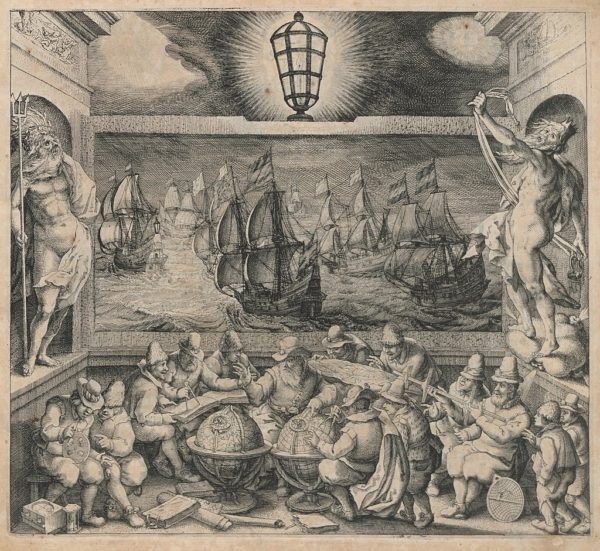
With how big the world is, it is no surprise that people have developed ways of navigating and exploring to prevent getting lost. Early navigators at sea used different methods to find their way around the ocean, including the use of astronomy and watching constellations to find out where they currently are. The Minoans in the Mediterranean left records as old as 3000 B.C.E. showing that they used the stars to navigate. However, while using stars and staying close to land made it easy to navigate coastlines and nearby islands, exploring the open sea was a much more dangerous situation to tackle for early explorers. Early navigators used basic tools such as constellation charts and records of currents and wave patterns to find their way at sea. Ancient Norse mariners used a tool called a sunstone (actually a piece of Iceland Spar) to find the sun to navigate even under cloudy and foggy conditions. In the 6th Century, astrolabes were to calculate the position of the Sun and stars relative to the horizon and meridian. This would be replaced with the sextant in the 18th century, which was easier to use and more reliable. Compasses were also created to help with locating the magnetic North Pole, making exploration significantly easier in modern times.. Today, modern technology such as GPS and satellite-based navigation has made maritime navigation significantly easier.
However, one other difficulty most explorers encountered in the past was navigating in the dark. Evidence of the use of fire by early humans and hominins dates back as far as 1 million years ago. Ancient campfires were discovered in South Africa’s Wonderwerk Cave, an early habitation site for humans, showing the importance of fire as a source of light, warding predators, and survival purposes. With the growth of civilizations, torches were developed using wood, fabric, and various combustible materials, allowing light and fire to be brought on journeys and illuminate the places humans travelled. Different civilizations, including Egypt, Rome, China, and many others began developing wicked candles using papyrus or paper dipped in tallow or beeswax, with the earliest candles being developed around 3,000 B.C.E. Whale oil was popularly used as lighting fuel in Colonial Times, but was later replaced with processed waxes, such as stearin.
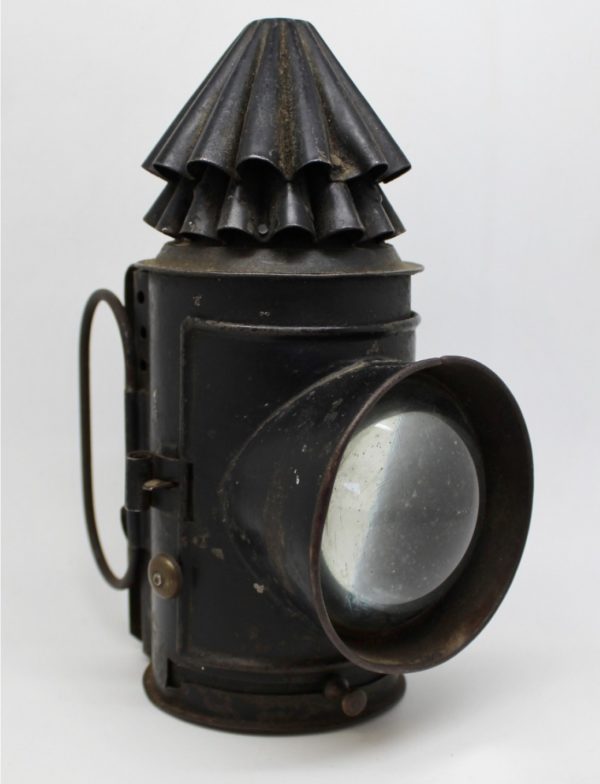 Finally, lanterns were used to carry the flames produced by lighting oil and candles. The earliest known lanterns were found in classical sites, such as Herculaneum. These were made of bone and metal, allowing light sources to be moved from room to room. Bulls-eye lanterns were created later on to turn off the lantern until it was ready to be used (by flicking a switch on the side to open the shutters). These focused light sources became the earliest form of flashlight. The development of shield glass also helped protect the light sources from the elements. Once the lightbulb and electricity were discovered, humans were finally able to find their way around the world.
Finally, lanterns were used to carry the flames produced by lighting oil and candles. The earliest known lanterns were found in classical sites, such as Herculaneum. These were made of bone and metal, allowing light sources to be moved from room to room. Bulls-eye lanterns were created later on to turn off the lantern until it was ready to be used (by flicking a switch on the side to open the shutters). These focused light sources became the earliest form of flashlight. The development of shield glass also helped protect the light sources from the elements. Once the lightbulb and electricity were discovered, humans were finally able to find their way around the world.
Take-and-Make Information:
Have you wanted to become the hero of your own story? Then join the Adventurer’s Guild! We will provide you with the tools you need to survive in any situation! This month, we explored topic of navigation, learning about how people found their way through unfamiliar places, from the brightest deserts to the darkest forests. Pick up your “Adventurer’s Firefly-in-a-Jar Lantern” Take-and-Make* at the La Plata Branch Library from one of our resident bug catchers by telling them ONE fact about bugs that you know about!
Supplies are limited, so pick up your kit today!
*Disclaimer: Please be aware that this kit does contain glass! Our bug catchers provided us their top-shelf bug-catching devices (i.e. glass jars), so please be careful when handling these kits! The Adventurer’s Guild is not affiliated with the bug catchers and are not liable for injury caused by misuse of these bug-catching devices.
Sources:
- National Geography: Navigation
- Britannica: Navigation
- The Viking Sunstone Revealed?
- The Story of the Astrolabe, the Original Smartphone
- Navigating to the Sextant
- Human Ancestors Tamed Fire Earlier Than Thought
- Forms of ceremonial and ritualistic objects according to their functions
- Candle History
- Britannica: Lantern Lighting

